Your Topics | Multiple Stories: How to Create Engaging Content
In today’s world, content is very important. How we tell our stories makes a big difference in grabbing attention. One powerful way to tell stories is using “Multiple Stories.” This means telling the same topic from different points of view. By doing this, you can keep your readers interested and help them understand the topic better.
In this article, we will explore what multiple stories are, how they help you tell a better story, and how you can use them in writing and marketing.
What Are Multiple Stories?
Multiple stories mean telling a topic in different ways. Instead of using just one point of view, you show many. For example, if you are writing about a school event, you could tell the story from the teacher’s point of view, the students’ view, and the parents’ view. This gives a fuller picture of what happened.
This technique is used in books, news stories, and even in advertising. It helps readers see a topic from different sides.
How Multiple Stories Help Tell a Better Story
Shows Different Views
When you use multiple stories, your audience can see the topic in different ways. This gives them a better understanding. For example, if you’re writing about a protest, you can show the view of the protesters, the police, and the community. Each view helps the reader see the full picture.
Keeps Readers Interested
Multiple stories also make the content more exciting. You can mix personal stories, expert opinions, and facts. This variety keeps readers engaged and prevents the story from getting boring.
Helps the Reader Learn More
When you tell a story from different points of view, the reader learns more. Instead of hearing only one side, they get a fuller understanding of the topic. For example, if you write about climate change, you can talk about how different people experience it. This helps readers see how big and complex the issue is.
Why Use Multiple Stories?
Boosts Creativity
Using multiple stories helps you think in new ways. You look at the topic from different angles. This makes the writing more interesting and helps you come up with fresh ideas.
Lets You Experiment
You can try different writing styles with multiple stories. One story can be funny, while another can be serious. This lets you play with different tones and voices, making your writing more fun and creative.
How Multiple Stories Help Readers
Keeps Them Engaged
Multiple stories help keep readers interested. Instead of reading the same thing over and over, they get new ideas and views. This makes reading more exciting.
Helps Them Connect
By using multiple perspectives, readers can connect with the story. Whether they relate to the people in the story or the events, they feel more involved. This connection makes them more likely to keep reading.
Gives More Value
When you use different stories, you give your readers more information. They learn different aspects of the topic. This adds value to the content and makes it more useful.
Tips for Writing Multiple Stories
Stay Organized
When writing multiple stories, it’s important to stay organized. Plan each story and think about how they will fit together. An outline can help you keep track.
Balance the Stories
If you use different characters, make sure they stay the same in each story. Keep the plot moving forward, and don’t let any story feel out of place.
Pace Your Stories
Pacing means how fast or slow the story moves. Some stories may need more time, and some should be quicker. Make sure the pacing is balanced so the reader stays interested.
Challenges of Writing Multiple Stories
Managing Different Plots
One challenge of writing multiple stories is keeping track of all the different parts. It can get confusing. The best way to handle this is by planning carefully. Keep notes on each plot so you don’t get lost.
Keeping the Pace Right
Sometimes it’s hard to keep all the stories at the right speed. Some parts of the story may feel too slow, while others may feel too fast. The key is to balance them well.
Making Sure Each Story Matters
Every story you tell should have a reason. If a story doesn’t add to the main message, consider removing it. Each story should help the reader understand the topic better.
Examples of Multiple Stories in Media
Cloud Atlas by David Mitchell
The book Cloud Atlas is a great example of multiple stories. It tells six different stories, each set in a different time and place. Even though the stories are very different, they are all connected by similar ideas. This creates a powerful experience for the reader.
Game of Thrones
The TV show Game of Thrones also uses multiple stories. It follows many characters with different storylines. By showing the same events from different points of view, the show makes the story more interesting and complex.
How to Use Multiple Stories for Marketing and Content Creation
In Writing
Using multiple stories in your writing can make your content more interesting. Whether you’re writing a blog, making a video, or creating a social media post, telling a story from different angles keeps your audience engaged.
In Marketing
Marketers can use multiple stories to appeal to different people. For example, a company could write several posts about a product. One post could talk about the product’s features, another could share customer reviews, and another could explain how the product helps solve a problem. This way, they can reach more people with different needs.
Conclusion
Multiple stories are a powerful tool for creating better content. They show the topic from many sides, which helps the reader understand it better. By using this technique, you can make your writing more interesting, keep readers engaged, and give them more value. Whether you are writing a blog, making a video, or doing marketing, multiple stories can make your content stand out and connect with your audience in new ways.
For More More Visit: Creative Blogs


